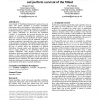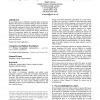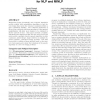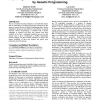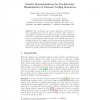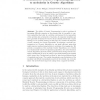GECCO
2007
Springer
14 years 12 months ago
2007
Springer
A new family of "Distribution Replacement” operators for use in steady state genetic algorithms is presented. Distribution replacement enforces the members of the populatio...
GECCO
2007
Springer
14 years 12 months ago
2007
Springer
In many design tasks it is difficult to explicitly define an objective function. This paper uses machine learning to derive an objective in a feature space based on selected examp...
GECCO
2007
Springer
14 years 12 months ago
2007
Springer
Engineering design increasingly uses computer simulation models coupled with optimization algorithms to find the best design that meets the customer constraints within a time con...
GECCO
2007
Springer
14 years 12 months ago
2007
Springer
The use of machine learning techniques to automatically analyse data for information is becoming increasingly widespread. In this paper we examine the use of Genetic Programming a...
EVOW
2007
Springer
14 years 12 months ago
2007
Springer
Abstract. We demonstrate how a genetic algorithm solves the problem of minimizing the resources used for network coding, subject to a throughput constraint, in a multicast scenario...
EVOW
2007
Springer
14 years 12 months ago
2007
Springer
In this paper we study a complex real-world workforce scheduling problem. We propose a method of splitting the problem into smaller parts and solving each part using exhaustive sea...
EVOW
2007
Springer
14 years 12 months ago
2007
Springer
Abstract. This paper presents a novel hybrid approach for solving the Container Loading (CL) problem based on the combination of Integer Linear Programming (ILP) and Genetic Algori...
EUROGP
2007
Springer
14 years 12 months ago
2007
Springer
The ability of Genetic Programming to scale to problems of increasing difficulty operates on the premise that it is possible to capture regularities that exist in a problem environ...
AIIA
2007
Springer
14 years 12 months ago
2007
Springer
In this paper we compare four selection strategies in evolutionary optimization of information retrieval (IR) in a question answering setting. The IR index has been augmented by li...
AE
2007
Springer
14 years 12 months ago
2007
Springer
We propose using the so called Royal Road functions as test functions for cooperative co-evolutionary algorithms (CCEAs). The Royal Road functions were created in the early 90’s ...
